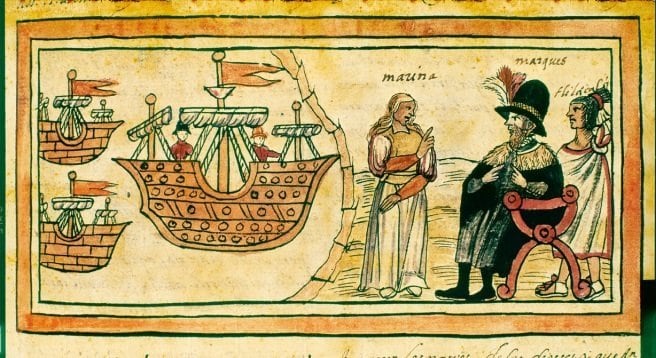# 2 La Malinche, Heroin or Villain?
In LINCE Spanish School we constantly address cultural topics and today, we are sliding over to Mexico, one of the first countries of the Spanish Conquests lead by Hernan Cortes. In particular, we are focusing on the figure of La Malinche, a nahuatl women that opened the new lands for the Spanish conquistadors and who would be key in the expansion of the territories for the Spanish crown.
Born around 1500s near Coatzacoalcos (the current region of Veracruz) in the heart of a noble family (her father was a feudal chief of the Aztec Empire) she received the name Malinalli. After the death of her father, the young girl was sold to a chief of Tabasco where she learned the Mayan language. On March 14th, 1519, the Spanish army, commanded by Hernan Cortes confronted the indigenous tabasco people at the Battle of Centla, where they were defeated. As a tribute, the local chiefs presented the conquistadors with gold, blankets, foodstuff and twenty young virgins among them, Malinalli. After her baptism, the young nahuatl received the name Marina, which later she would be known as La Malinche.
The nine Christians were given out to the captains of the Spanish army and Marina was assigned a partnership with Cortes, Alonso Hernandez Portocarrero. Marina began to help Hernan Cortes as an interpreter of the nahuatl language, Mayan and later Spanish, and as a counselor she showed him the customs and military tactics of the Aztecs.
First finding of Malinalli with Hernan Cortes. Antique manuscript by Diego Duran, 16th century. (National Library of Madrid)
Meanwhile, Alonso Hernandez Portocarrero had to return to Spain and Marina became the lover of Cortes and from this relationship, Martin was born, possibly the first mixed-race born in the Americas. After the conquest of Tenochtitlan, the Aztec capital, Cortes made Marina marry a Spanish nobleman Juan Jaramillo, with whom she had a daughter, Maria. From that point on, the trail of Marina is lost, but it is known that she died befor 1529 because of the paperwork done by her husband to remarry.
The figure of Malinche moves between reverence towards women that founded the nation of Mexico and with others making comparisons with the Virgin Maria or La Llorona (spirit of a tortured soul) or even a traitor to the indigenous culture and mother of the mixed-races. From this opinion, the derogatory term malinchismo was born, referring to a person who sells to foreigners and who undervalue their own people or culture (have a look at the song by Mexican composer and singer Gabino Palomares, Maldicion de Malinche)
In the last few decades, there have been attempts to change the negative image of La Malinche and they have made the effort to try to recognize the influence and the importance of this indigenous noble in the history of Mexico.
Statue of La Malinche en Oluta, Veracruz (México)


